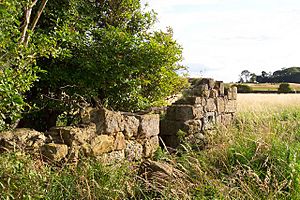Kilspindie Castle facts for kids
Kilspindie Castle is an old ruined castle located near the village of Aberlady in East Lothian, Scotland. Its remains are found behind the St Mary's Kirk church. This castle has a long history, but today, only a few scattered stones and parts of its base remain. You can still see a bit of wall with oval holes, which were likely for guns. The area where the castle once stood is now a protected historical site called a scheduled monument. There was also another ruin called "Kilspindie Castle" near Coldingham.
Contents
The Story of Kilspindie Castle
Ancient Times at Kilspindie
Even before the castle was built, people lived in this area for a very long time. Scientists have found many old metal objects here, showing that people have been using this spot continuously. It's also where the most Anglo-Saxon items have been found in all of Scotland!
The Douglas Family Takes Over
Long ago, a small fort at Kilspindie was owned by the Spens family. They might have been loyal to the Gospatric Earls of Dunbar.
Around the early 1500s, the powerful Douglas family took control of Kilspindie. This happened after a conflict with the Spens family. Archibald Douglas, 5th Earl of Angus, also known as "Bell-the-cat," was a key figure in this change. The Douglas family gained the lands of Aberlady from the Crown. It's thought that the name Kilspindie might have come from a village with the same name in Perthshire. Later, Archibald Douglas of Kilspindie used the nickname "Greysteil," which might refer to how the Douglas family gained the land. Archibald's fourth son later became the Treasurer of Scotland from 1520 to 1528.
Wars and Destruction
In the 1540s, Scotland faced wars with England, known as the Rough Wooing. Many castles, churches, and villages in the Lothians and Borders areas were attacked and burned. Surprisingly, Tantallon Castle, which belonged to the Earl of Angus, and Hugh Douglas's Longniddry Tower were not attacked. This was because Hugh was an "assured Scot," meaning he had an agreement with the English, which helped protect Douglas family interests.
However, in 1547, the English returned. They defeated the Scottish army at the battle of Pinkie near Musselburgh. The next year, they set up a fort in Haddington and attacked nearby castles. Luffness Castle was destroyed so that English supplies could reach Haddington easily. It's very likely that Kilspindie Castle was also destroyed around this time because it was located right on Aberlady Bay.
A New Castle is Built
After the old castle was destroyed, Patrick Douglas of Kilspindie built a new "castell toure and fortalice" (a castle tower and small fort) before 1600, possibly as early as 1558. This new castle was probably shaped like a rectangle. It would have had a strong outer wall called a barmkin to protect the stables, brewery, and barns. This barmkin would have been surrounded by a deep ditch. This ditch would fill with water from the tide and keep it there with wooden dams when the tide went out. The land around the castle was also a tidal salt marsh, which made it even harder for attackers to reach.
By 1612, Kilspindie was given to Alexander Hay. He received it through his marriage to Patrick's widow in 1582. Kilspindie is not mentioned during Oliver Cromwell's attacks on Lothian castles in the 1650s. However, by the 1700s, the castle had already been taken apart. Its stones were used to build other things in Aberlady. You can still see some large stones from the castle in the walls of fields and the road leading to the golf course. A heavy, studded door from the castle is now kept at Luffness House.


